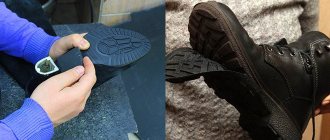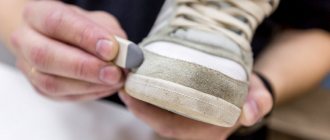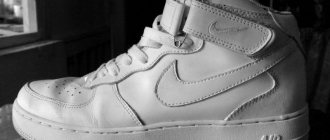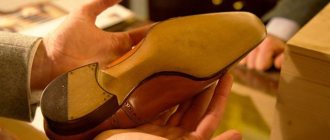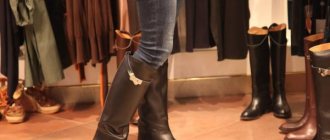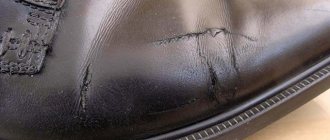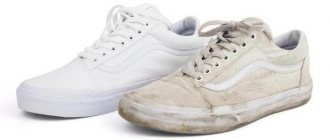Even the highest quality shoes can become damaged during use, as they are constantly exposed to moisture, dirt, or even just time. The sole of the shoe is damaged to a greater extent, because it is subjected to constant stress. Over time, cracks and severe tears may appear on the sole.
Ideally, a damaged pair should be taken to a professional repair shop. However, if this is not possible, then you can repair the shoes yourself. Repaired shoes can serve you well for a long time. In this article we will tell you in detail how you can seal a hole in winter shoes at home.
What kind of glue can you use to glue the sole of a shoe?
You need to be careful when choosing glue for shoes. Before purchasing, you need to find out whether it is suitable for repair. The following brands of glue are suitable for gluing:
- "Moment Marathon".
- "Desmokol."
- "Shoemaker".
- "Nairit."
- Epoxy resin.
- "Kedra Farben".
- "Bonicol".
"Moment Marathon" was developed specifically for shoe repair. The composition is resistant to moisture, frost and negative environmental influences. But we must take into account that it is not suitable for gluing polypropylene, plasticized PVC, styrofoam and polyethylene. You can wear shoes a day after gluing.
“Desmokol” is a transparent glue containing polyurethane, due to this you can repair suede shoes and glue PVC materials. It is sold in specialized stores and used in shoe workshops.
Polychloroprene rubber is contained in the adhesives “Sapozhnik” and “Nairit”. They are suitable for gluing leather materials. The composition dries in 1-2 days. They are used in professional workshops, since when repairing shoes, shrinkage remains minimal.
Epoxy resin is a durable, waterproof layer, so it is ideal for gluing soles. Used for repairing sports and casual shoes, it dries in two days, but gives minimal shrinkage.
"Bonicol" and "Kedra Farben" are imported adhesives developed specifically for the shoe industry. Suitable for working with natural and artificial leather, repairing heels and insoles.
The listed compositions contain flammable components, so leaving them close to a fire source is strictly prohibited. It is recommended to store the tubes out of the reach of children.
Recovery methods
Depending on the degree of damage, the location of the crack or the volume of the hole, a person must independently choose a technique that will be relevant in a given situation.
To make it easier for a beginner to solve the problem, it is worth citing several popular methods that most experienced craftsmen resort to; relying on them, the question will no longer look so complicated.
Installing a patch
The rubber element is used in the repair of a wide variety of shoe models, from sneakers to winter boots with large treads.
Most often, such drastic measures are provided to eliminate volumetric defects, holes or significant damage that extends to the main frame of the model.
In order to apply the method and not spoil the appearance of the shoes, and also not make them uncomfortable for walking, you need to clearly measure the dimensions of the patch, then trim the base, and also adjust the element until the mixture hardens.
Gluing the area with special glue
Strong samples of fixing compounds are very popular; with their help, you can reduce the time required to perform manipulations, as well as obtain high-quality adhesion between planes.
Such adhesive models are not cheap, but the result is worth it, the composition was developed at the manufacturer specifically for shoe repair, so the structure of the solution completely fills the gap or hole. At the moment of implementing the technique, zigzag strips are cut out on the base with a knife, they will be filled with glue.
You must work with purchased products exclusively according to the instructions; there is no need to deviate from the manufacturer’s recommendations; in the process, the technician protects his hands, respiratory organs and ensures ventilation of the room.
Partial replacement of the damaged area
In difficult cases, you cannot do without cutting a certain area, but such manipulations will need to be done carefully so that the knife does not jump off and the person does not remove excess part of the material.
A polyurethane piece or rubber is applied to the free space, this element must be adjusted to size, and the edges must be perfectly cleaned; sandpaper creates a matte surface texture to which the fixing mixture adheres.
In rare cases, over time, the insert disappears, but to avoid such an excess, you need to choose the right glue and follow the advice of experienced shoemakers when performing the work.
Which glue is better not to use?
To glue the sole, it is better to use adhesives designed specifically for this purpose. It is not recommended to use:
- ordinary PVA, since it is not waterproof, the sole will immediately peel off after getting wet;
- compositions from the “Superglue” category - the connection will be rigid, the shoes will deform, unable to cope with the heavy load, as a result the material will tear;
- adhesives for installing ceiling tiles - they cope with their main task, but leave stains, so the shoes become unwearable.
It is better to buy a suitable adhesive composition in a specialized store. It is necessary to select an option for a specific material so that the gluing is high-quality and accurate.
Your own shoemaker
Most people in this situation try to repair shoes or boots on their own. Sometimes this is successful, but sometimes it leads to disastrous results, and the shoes still have to be taken to the shoemaker to eliminate the consequences of inept repairs. So what to do?
Don’t get upset and don’t rush to throw away your favorite shoes that are “begging for porridge.” Many troubles can be eliminated at home. You just need to get down to business correctly and stock up on suitable materials.
The lion's share of all repairs involves sealing a leaky pair of shoes. And here, a thoughtless purchase of the wrong type of glue can ruin all your efforts. Remember: you need to choose reliable and high-quality glue for shoe repair! And our article, we hope, will help you make an informed choice.
Options for gluing soles
You can glue the sole using hot or cold methods. Each of them has its own pros and cons.
Cold way
To glue shoes using the cold method, you must perform the following steps:
- clean, degrease and thoroughly dry the steam to be worked with;
- carefully apply the selected adhesive;
- Press the elements to be glued firmly against each other, making sure that there are no voids left;
- place the shoes under pressure for the time required for complete gluing (indicated on the packaging, usually it ranges from 10 hours to 2 days).
The drying time is indicated on the glue packaging; if you ignore it and put the boots on faster, the sole will come off again.
Hot way
Suitable for repairing shoes with hard soles. The glue is applied evenly over the entire surface and dries within 30 minutes. After this time, use a gas burner or hairdryer to heat the sole, then press the upper part firmly against it, holding for 15-20 seconds. When using this method, you can put on shoes after 2 days.
Possible mistakes
Sometimes laudable independence in home shoe repair can result in unexpected troubles. Especially when you ask the question: “What good shoe glue can I buy inexpensively?” to a friend who understands this no more than you.
Any shoemaker will tell you many stories about how they had to - sometimes at the cost of considerable effort - correct the mistakes of unfortunate shoemakers. And most often, problems can be caused by incorrect selection of the starting material for repairs.
Therefore, it’s time to talk about what glue to use when repairing shoes is extremely undesirable or even strictly prohibited.
Important tips for sealing soles
To glue the sole securely and for a long time, you will need a sharp cutting tool with a thin blade, a degreaser, sandpaper, and clean rags. Before work, it is better to prepare foam rubber, old newspapers, a spatula and a glue brush in advance; they may be needed at any time. Algorithm for gluing shoe soles:
- inspect and assess the extent of damage;
- remove metal heels;
- clean the surface from dirt, degrease it, carefully remove the remnants of old glue;
- dry well;
- sand the parts to be glued together;
- apply a thin layer of glue to both surfaces to be glued;
- wait 10 minutes until it dries a little;
- for elements with a porous base, the glue must be reapplied in a second layer.
It is recommended to carry out gluing in a well-ventilated area, since the glue contains toxic substances. During work, smoking or being near an open flame source is prohibited.
Method 2
For work you will need the following materials:
- shoe knife;
- sandpaper;
- acetone or gasoline;
- a piece of inner tube from a bicycle;
- rubber glue.
What should be done:
- As in the first case, the burst sole needs to be cleaned and degreased. Use a shoemaker's knife to remove part of the sole: cut 5 mm along each edge of the crack. Keep the cutting depth to approximately 1 mm.
- The next step is to measure the depth of the fracture at the base. Add 15 mm to the resulting value - this will be the width of the strip that needs to be cut out of the chamber.
- Clean the cut strip, degrease it thoroughly, and apply rubber glue to it. Cover one side completely with glue, and leave a 5 mm edge of the dry surface on the other.
- Take the damaged shoe and bend it so as to expose the crack as much as possible. Holding it in this position and not closing it for 10 minutes, apply glue to the damaged area.
- Bend the prepared strip from the chamber in half and insert it into the crack. Now the sole can be straightened. With pressure, press the edges of the strip protruding from the crack onto the surface of the sole. Place your shoes under something heavy for a day.
How to seal a hole in a sole
Holes often form on shoes with soft soles. Regardless of its size, the product must first be cleaned, degreased, and dried well. After completing these steps, the hole is sealed with glue. If the hole is large, then a fiberglass mesh is placed in it. The sole is sealed with construction tape so that no bumps form on it and it remains level. Remove it after the glue has completely dried. To fill holes in the sole, it is recommended to use American polyurethane Seam Grip; an alternative is DoneDeal epoxy resin.
If the sole bursts
If the sole cracks after the warranty period, a more complex restoration option is required.
What will be needed for repairs
- Scotch.
- High-quality polyurethane glue.
- Soldering iron.
- Small spatula.
- Copper tip for a soldering iron (you can take any piece of wire that is suitable in diameter, since it will have to be thrown away after repair).
- Fiberglass mesh.
- Small brush.
- Acetone.
- Hair dryer.
Important! Buy polyurethane adhesive only from well-known brands, such as TEROSON. There are quite a lot of fakes on the market at the moment, so you need to be more careful when purchasing.
How to properly seal a sole with voids
You can seal a sole that has voids using the following instructions:
- clean and degrease the surface;
- carefully fill the voids with microfiber scraps;
- seal everything with sealant;
- after it hardens, degrease the surface again;
- glue the upper part of the shoe with the sole using the instructions above.
You can use adhesives not only to glue the top and bottom of shoes, but also to prevent them from slipping in winter. To do this, a pattern is applied to the sole with glue, after it dries, it is processed with sandpaper.
Materials and tools to fix shoe problems
The list of accessories and components for repair can be changed depending on the chosen method for implementation, but most often on the table of a professional shoemaker you can see such things as:
- A sharp knife with a thick and thin blade.
- A roll of sandpaper.
- Liquid for degreasing surfaces.
- Glue.
- Heat source, veins or paraffin candle.
- Marker for marking.
- Rubber scraps of different thicknesses.
- Tweezers.
- Brush.
- Heavy objects or vices.
The place where manipulations are carried out should also be taken seriously; it is prepared in advance by placing several lighting fixtures.
Since the work is sometimes very delicate, when viewing the surface it is important to notice all the nuances, and the room must be constantly ventilated and dry so that the material does not become saturated with moisture.
Methods for sealing summer and winter shoes
Spring and autumn, demi-season and winter shoes are often characterized by a honeycomb or lattice sole design. If the sole of such products bursts, as well as with prolonged wear, it gradually wears out. Voids form inside and the heel may fall through.
To restore such products, you must first remove the rubber that covers these honeycombs. To do this, tear off the insole and thoroughly clean each hole of dirt, debris, cardboard and glue residues. Then the empty honeycombs are filled with small micropore scraps and filled with silicone sealant.
Restoration continues once the sealant has dried and hardened. Prepare new insoles, soak them with sealant or glue, glue them to the sole of the shoe and press with a weight for the time specified in the instructions for the adhesive.
For summer shoes, sneakers, sneakers and other light shoes, you can buy a separate thin rubber sole and glue the products with rubber glue. This method is suitable if the products have flat soles. When gluing rubber to leather shoes, first make a 45-degree edge.
To ensure that the rubber sticks firmly and permanently to the polyurethane or nylon base of the shoe, first cut a template from cotton fabric to size and weld it to the base using a hot iron. Then glue on the new sole.
After repairs, it is important to monitor the shoes and care for the pair. Wash and dry items regularly. Which shoe polish is better to choose, see here.
Contact, Desmokol and Moment
Contact is a cheap product from a domestic manufacturer, which ranks second in terms of sales volume on the market, behind Moment. Glue can be used to seal porcelain, rubber, ceramics, leather, silicone products and other materials. It fills all gaps and penetrates deep into cracks.
Desmokol is a polyurethane shoe adhesive . It has increased ductility, strength and moisture-repellent characteristics. Sold in tubes of various sizes. The product can also be purchased in the form of granules, which, when prepared at home, must be diluted with a solvent, for example, acetone. Which shoe glue is better to choose, ready-made or dry, everyone must decide for themselves.
Moment Marathon from the Irish company Henkel is an effective shoe adhesive gel that is not only easy to use, but also quite economical. For a tube weighing 3 g you will have to pay 150 rubles. Thanks to its fairly thick consistency, problems with drips never arise, and the thin spout distributes the glue strictly to the required areas.
If you still have doubts that you won’t be able to seal your shoes yourself, it’s better to take them to a workshop. However, in some cases, old boots are not worth spending money on repairing.
It is known that there are no shoes that last forever; even the highest quality shoes from the best manufacturers need repair. The best shoe glue will help to significantly extend the life of your favorite shoes, subject to careful care and timely repairs. If you are interested in which adhesive for gluing soles is best suited for your shoes, sandals, boots, we suggest that you familiarize yourself with the rating compiled based on reviews from numerous customers. The top 8 includes reliable examples of time-tested shoe adhesives. In the review article you can familiarize yourself with the positive and negative characteristics for each position in our rating.
Kenda Farben and Uhu Schuh
Kenda Farben is considered the best glue for shoes. It is produced in Italy. The average price per tube is 510 rubles. It is used for various purposes. In addition to textiles, leather and rubber, it works well on glass, wood and metal. The main thing is to properly prepare the bonding surfaces; their temperature should exceed 17 °C. Shoemakers enjoy using this waterproof sealant. The materials adhere instantly, which saves work time. Maximum strength is achieved after two days .
Uhu Schuh & Leder is a German brand at an affordable price . The product is suitable for sneakers, rubber soles, heels, gluing hard and soft materials, the tension between which is compensated by the elasticity of the seam. The composition repels water, resists acids, alcohol and alkalis, and can withstand a temperature range from +125 °C to -20 °C. Another plus is that the product does not dry out over time. Its price starts from 270 rubles.
There are three ways to glue the sole of a shoe:
- contact;
- inactivated solvent;
- thermal activation.
The remaining adhesive is removed quite easily - just use butanol or ethyl acetate.
To ensure high-quality adhesion, the surfaces must be washed, dried and degreased before the procedure.
